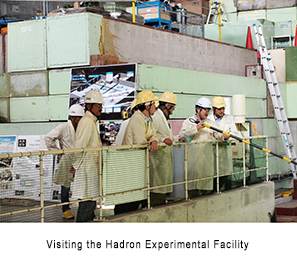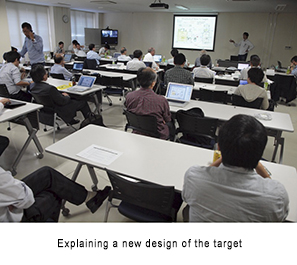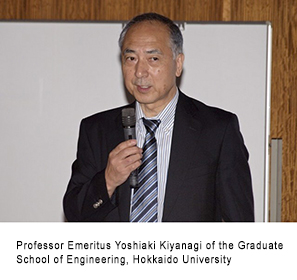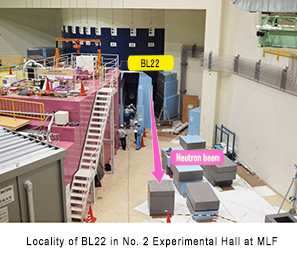| Ā°Ā@J-PARC News - October 2013 (Issue #102) |
| ĀúReorganized J-PARC Center to reinforce safety (October 1) |
| In dealing with the radioactive material leak accident at the Hadron Experimental Facility, the High Energy Accelerator Research Organization (KEK) and Japan Atomic Energy Agency (JAEA) examined and reviewed the safety management system to prevent accident recurrence, and implemented a reorganization of J-PARC on October 1.
For the new organization top priority is placed on safety, and a clear command structure was developed to respond in case of an emergency. Independency of the Safety Division, particularly the Radiation Safety Section, was enforced making a clear separation between safety management and research. A new Deputy Director position was created to take full-time responsibility for all aspects of safety. This Deputy Director is in charge of safety issues throughout the J-PARC Center, including overseeing the response if an abnormal situation occurs, and supervising work in the Safety Division. Dr Baba, who is an emeritus professor of Tohoku University, was appointed as the Deputy Director.Ā@In addition, two sections, the Neutrino and the Hadron Sections, have been newly established under the Particle & Nuclear Physics Division, thereby clarifying their safety management demarcation and organizational division. |
  |
 * Click here to enlarge. * Click here to enlarge. |
| Ā£to Page Top |
|
| ĀúReview Committee for the Target System and Related Matters of the J-PARC Hadron Facility (October 8-9) |
| The Review Committee for the Target System and Related Matters of the J-PARC Hadron Facility (HD Facility) convened on October 8-9 at the Tokai 1-go-kan of the High Energy Accelerator Research Organization (KEK). The main role of this committee is to provide evaluation, review and advice regarding the renovation plan, particularly for the target and related facilities, with the aim of preventing accident recurrence and improving safety of the HD Facility. The committee has five experts, including two from overseas and is chaired by Dr. John Haines, head of the Target Division at the European Spallation Source (ESS).
At the opening of the meeting, the Director of the J-PARC Center, Yujiro Ikeda, explained the main reasons for convening the committee. Then the J-PARC staff members in charge of each area explained specific topics including: an overview of the Hadron accident, the slow extraction system from the 50-GeV synchrotron to the HD Facility, an overview of renovations of the HD Facility to improve safety, target design, design of components such as the target vessel and gas/water cooling system, various control/monitoring systems, and the sealed structure of the beamlines. After the overview of the accident on the first day, the committee members visited the accident site at the HD Facility.
The committee was joined by two observers from J-PARC, and there were lively question-and-answer sessions and discussions regarding each report. At the end of the meeting, a report was issued by the committee-in the form of findings, comments and recommendations-on the facility renovation plan and other topics. |
   |
 * Click here to enlarge. * Click here to enlarge. * Click here to enlarge. * Click here to enlarge. |
| Ā£to Page Top |
|
| As a result of reflection on the accident involving leakage of radioactive material at the Hadron Experimental Facility (HD Facility), the J-PARC Center has prepared a safety card both in Japanese and English bearing safety slogans as one part of efforts to foster a more robust safety system. The safety card allow the holder to see at a glance the grid map of the J-PARC facilities, who to contact in an emergency, evacuation locations and other information. This card will be useful for responding when an emergency situation occurs. We will strive to raise day-to-day safety awareness by having J-PARC staff, other involved persons, and experimental users carry this card.
The safety card will be distributed to each user at the users office on arrival. |
  |
 * Click here to enlarge. * Click here to enlarge. |
| Ā£to Page Top |
|
| At a meeting of the European Physical Society held in Stockholm in July of this year, the International T2K Collaboration (T2K) announced, for the first time in the world, that the "Electron Neutrino Appearance Phenomenon," in which a muon neutrino transforms during flight into an electron neutrino, definitely exists. This Neutrino Collaboration Meeting was the first since that announcement, and was held for six days, from September 30 to October 5, at the Ibaraki Quantum Beam Research Center (IQBRC). The participants were 190 researchers and grad-students involved in the T2K Experiment (154 from overseas). For the first half of the meeting, participants broke into groups and held pre-meetings, and then general meetings were held starting on October 3. In the opening session, Takashi Kobayashi, Head of the Particle & Nuclear Physics Division (Professor, KEK) reported on the results of the review by the Program Advisory Committee regarding the research direction of T2K after this discovery of the "Electron Neutrino Appearance Phenomenon." In addition, C. K. Jung (Professor, The State University of New York, and International Co-spokesperson of T2K) indicated his appreciation of the fact that stable operation of the J-PARC facility after early recovery from the 2011 disaster was essential for achieving this result. When he said this, the audience warmly applauded Yujiro Ikeda, Director of the J-PARC Center.
At this meeting, there were reports on the latest results regarding the "Electron Neutrino Appearance Phenomenon" and the similarly important "Muon Neutrino Disappearance Phenomenon," as well as the status of efforts such as integrated analysis of the two. There was lively discussion of topics such as plans for replacement of beamline devices and electromagnetic horns to accept even higher intensity beams, plans to renovate near detectors to further suppress systematic error of the experiment, and plans for future experiments, including production of anti-neutrino beams to search for CP violations. |
|
| The Third Imaging Workshop using Pulsed Neutron Beams was organized by the Materials & Life Science Division of J-PARC, and held on October 11 in Tokyo. The neutron imaging technique is a widely-used experimental technology for non-destructively observing and analyzing the inside of materials by using the high penetration capabilities of neutrons in matter. At J-PARC, we are constructing a "Energy Resolved Neutron Imaging System: ERNIS", which will be the world's first dedicated system for imaging with pulsed neutrons, on BL22 in the No. 2 Experimental Hall of the Materials and Life Science Experimental Facility (MLF).
The workshop began with a greeting by Professor Emeritus Yoshiaki Kiyanagi of the Graduate School of Engineering, Hokkaido University-a representative of those proposing ERNIS. After that, there were reports by various persons involved with the system on the current status of the J-PARC facility, the imaging method using pulsed neutrons, the current state of the system and the desired performance, the beamline (BL) construction situation, and the development of data analysis and related programs for data processing. Regarding the BL construction situation, Takenao Shinohara (Assistant Principal Researcher, Japan Atomic Energy Agency (JAEA)) and Tetsuya Kai (Assistant Principle Researcher, JAEA) from the Neutron Science Section of the J-PARC Center reported on an overview of the system, the installation location, detectors, computers, and preparations such as data analysis. That was followed by six presentations by users expected to use the system after it is completed, from a variety perspectives including basic/applied research and industrial applications using pulsed neutron imaging, as well as the technology's role in improving corporate engineering capabilities and boosting international competitiveness.
(Supplemental explanation)
At present, technology is being developed at J-PARC to visualize crystal structure, constituent elements, temperature in materials, and magnetic field distributions by using BL10 (NeutrOn Beam-line for Observation and Research Use: NOBORU) and exploiting the characteristics of pulsed neutrons. The new imaging system using pulsed neutron beams incorporates these findings, and strives to achieve imaging with even higher resolution and contrast. |
  |
 * Click here to enlarge. * Click here to enlarge. * Click here to enlarge. * Click here to enlarge. |
| Ā£to Page Top |
|
| The "Memorandum of Collaboration (MOC) between the CKorJ-PARC, the Japan Atomic Energy Agency (JAEA) and the High Energy Accelerator Research Organization (KEK) for Initiating Cooperative Activity in the Fields of J-PARC Related Researches," which was concluded on October 1, 2010, was extended by a further three years on October 1 because the three year term of the MOC was set to finish at the end of September.
CKorJ-PARC is a support center which was authorized by the South Korean government, and established within Seoul National University in May 2010 to smooth research activities by Korean users using J-PARC. On October 5, 2010, the center's Japan office was opened in the Ibaraki Quantum Beam Research Center (IQBRC).
【Specific support provided by the J-PARC Center based on the MOC】
1) Support for operation of the CKorJ-PARC Japan office
In December 2010, an agreement on "Administrative Cooperation in Expenditure of the CKorJ-PARC Fund in Japan" was concluded with the JAEA. A bank account was opened for transferring funds between South Korea and Japan, and measures were taken to smooth office procedures for the secretariat of the Japan office.
2) Support for exchanging information and staff, and for holding seminars and other technical meetings
Six interns were accepted from universities in South Korea. In addition, during the period from 2010 to the end of June 2013, 83 people visited Japan for activities such as joint research, and 79 people visited South Korea from Japan, for activities such as information exchange.
3) Preparations for a joint research program
Cooperation when the "Agreement on Joint Research in Nuclear and Hadron Physics" was concluded between Seoul National University and the Advanced Science Research Center of the JAEA in November 2011. |
  |
 * Click here to enlarge. * Click here to enlarge. |
| Ā£to Page Top |
|
Copyright 2011 JAEA and KEK Joint Project. All rights reserved.
|
|